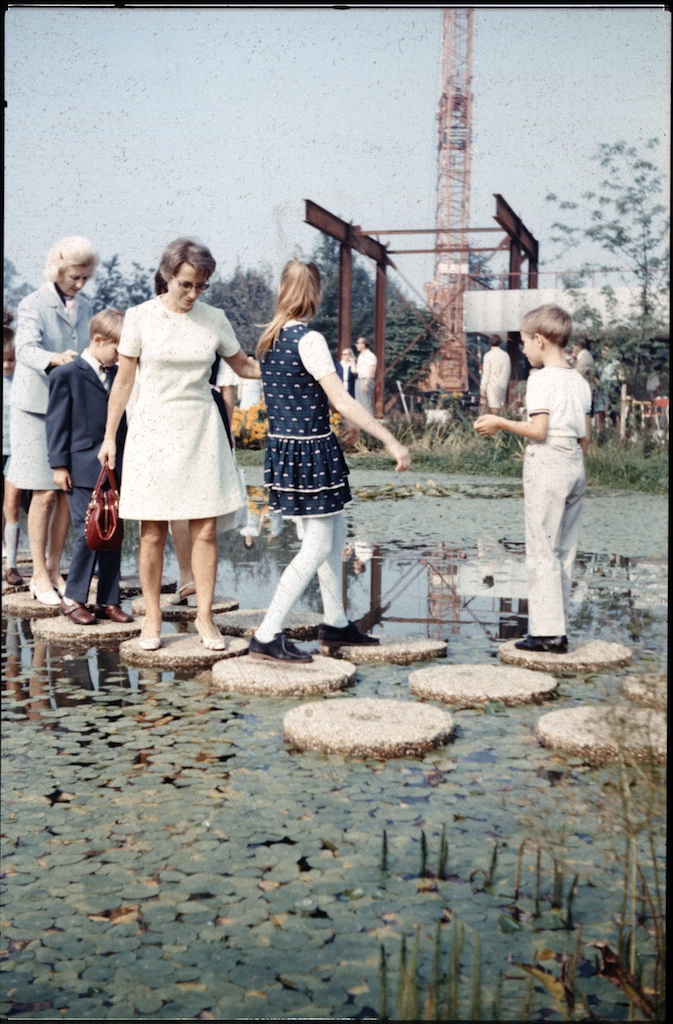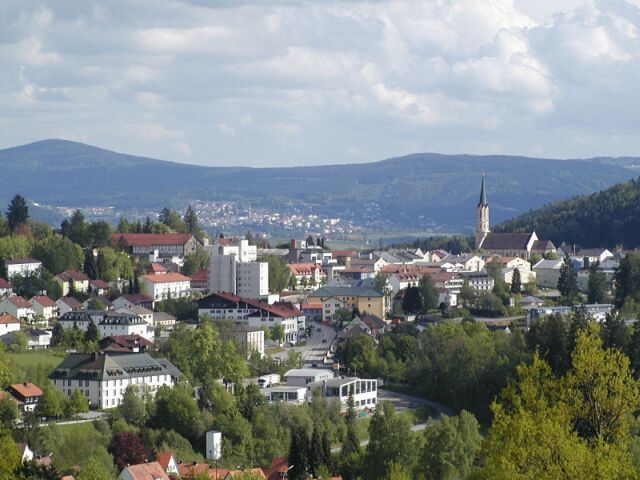|
Waldkirchen
Waldkirchen is the biggest town in the district of Freyung-Grafenau in Germany. History Mentioned for the first time in 1203, it soon became an important trading place along the "Goldener Steig" (Golden Path), a salt-trading route between Bavaria and Bohemia in the late Middle Ages. In the 13th century the Bishop of Passau gave Waldkirchen the title of a "Markt" (market). After several raids by Bohemian soldiers during the 15th century the city built a "Ringmauer", a big stonewall, to surround it, which is still to be seen in many places of the city. Belonging to the Bishop of Passau's territory for more than 600 years, the city became part of the Kingdom of Bavaria in 1806 and in 1871 of the German Empire. Waldkirchen burned down six times between 1492 and 1945. The last fire was on April 26, 1945, when the 16th Company of Regiment Grossdeutschland, SS Panzer Grenadier Division "Das Reich" arrived from St. Pölten, Austria. Each squad of ten men was armed with one light mach ... [...More Info...] [...Related Items...] OR: [Wikipedia] [Google] [Baidu] |
Bavarian Forest
image:Zell-bayerischer-wald.jpg, The village of Zell in the Bavarian Forest The Bavarian Forest ( or ''Bayerwald'' ; ) is a wooded, low-mountain region in Bavaria, Germany, that is about 100 kilometres long. It runs along the Czech Republic, Czech border and is continued on the Czech side by the Bohemian Forest (Czech: ''Šumava''). Most of the Bavarian Forest lies within the province of Lower Bavaria, but the northern part lies within the Upper Palatinate. In the south it reaches the border with Upper Austria. Geologically and geomorphologically, the Bavarian Forest is part of the Bohemian Forest - the highest of the truncated highlands of the Bohemian Massif. The area along the Czech border has been designated as the Bavarian Forest National Park (240 km2), established in 1970 as the first national park in Germany. Another 3,008 km2 has been designated as the Bavarian Forest Nature Park, established 1967, and another 1,738 km2 as the Upper Bavarian Forest Natur ... [...More Info...] [...Related Items...] OR: [Wikipedia] [Google] [Baidu] |
Emerenz Meier
Emerenz Meier (October 3, 1874 – February 28, 1928) was a German writer. She is most known for her work in Bavarian folk poetry. Biography Emerenz Meier was the daughter of Emerenz Meier, née Raab, and the farmer, livestock dealer and innkeeper Josef Meier in Schiefweg at Waldkirchen, Lower Bavaria. She started to write about her ''Heimat'' (homeland) as a child. In 1893, her first newspaper short story was published in Passau. In the autumn of 1896, her first and only book, ''From the Bavarian Forest'', was released in the East Prussian Königsberg. Because of the poor economic situation parts of the family emigrated to North America. In March 1906 Emerenz Meier followed her father and her sisters to Chicago. The expected personal economic upturn, however, did not occur. The First World War intensified her criticism of the political, economic and social conditions in Europe and America. Emerenz Meier died on February 28, 1928, in Chicago at the age of 53 years of complica ... [...More Info...] [...Related Items...] OR: [Wikipedia] [Google] [Baidu] |
Landesgartenschau
A ''Regional Garden Show'' (; ) is an exhibition on horticulture that takes place on a regular basis in several German and Austrian states. In Germany, a state horticultural show at the state level is the smaller counterpart to the Bundesgartenschau and the Internationale Gartenschau, International Horticultural Show, in Austria there is no counterpart so far. Germany History In the federal states of Baden-Württemberg and Bavaria state garden shows have been held since 1980. In North Rhine-Westphalia there was already a first state garden show in 1970, other German states adopted the model later. In the Austrian federal states Upper Austria and Lower Austria, too, state garden shows have been taking place for several years in alternating two-year cycles. In 1980, the first cross-border national horticultural show in Germany took place in Ulm/Neu-Ulm (Baden-Württemberg/Bavaria). Objectives and financing The garden shows are intended to improve the quality of life and the u ... [...More Info...] [...Related Items...] OR: [Wikipedia] [Google] [Baidu] |
Freyung-Grafenau
Freyung-Grafenau () is a Districts of Germany, ''Landkreis'' (district) in Bavaria, Germany. It is bounded by (from the south and clockwise) the districts of Passau (district), Passau, Deggendorf (district), Deggendorf and Regen (district), Regen, the Czech Republic and by Austria. History The district was established in 1972, by merging the former districts of Grafenau and Wolfstein. In medieval times Wolfstein (east of the Ilz River) was the property of the bishop of Passau and the site of Wolfstein Castle, now a ''schloss''. Grafenau (west of the Ilz River) successively belonged to different countries, before it was annexed by Bavaria in 1438. Wolfstein became a part of Bavaria two years after the dissolution of the clerical states in Germany (1803). Geography Freyung-Grafenau is the easternmost district of Bavaria. It is located in the southern part of the Bavarian Forest and is partially occupied by the Bavarian Forest National Park. The source of the Ilz River is situated in ... [...More Info...] [...Related Items...] OR: [Wikipedia] [Google] [Baidu] |
Bayerisches Landesamt Für Statistik
The statistical offices of the German states (German language, German: ) carry out the task of collecting official statistics in Germany together and in cooperation with the Federal Statistical Office of Germany, Federal Statistical Office. The implementation of statistics according to Article 83 of the Basic Law for the Federal Republic of Germany, constitution is executed at state level. The Bundestag, federal government has, under Article 73 (1) 11. of the constitution, the exclusive legislation for the "statistics for federal purposes." There are 14 statistical offices for the States of Germany, 16 states: See also * Federal Statistical Office of Germany References {{Reflist National statistical services, Germany Lists of organisations based in Germany, Statistical offices Official statistics, Germany ... [...More Info...] [...Related Items...] OR: [Wikipedia] [Google] [Baidu] |
Germany
Germany, officially the Federal Republic of Germany, is a country in Central Europe. It lies between the Baltic Sea and the North Sea to the north and the Alps to the south. Its sixteen States of Germany, constituent states have a total population of over 84 million in an area of , making it the most populous member state of the European Union. It borders Denmark to the north, Poland and the Czech Republic to the east, Austria and Switzerland to the south, and France, Luxembourg, Belgium, and the Netherlands to the west. The Capital of Germany, nation's capital and List of cities in Germany by population, most populous city is Berlin and its main financial centre is Frankfurt; the largest urban area is the Ruhr. Settlement in the territory of modern Germany began in the Lower Paleolithic, with various tribes inhabiting it from the Neolithic onward, chiefly the Celts. Various Germanic peoples, Germanic tribes have inhabited the northern parts of modern Germany since classical ... [...More Info...] [...Related Items...] OR: [Wikipedia] [Google] [Baidu] |
Middle Ages
In the history of Europe, the Middle Ages or medieval period lasted approximately from the 5th to the late 15th centuries, similarly to the post-classical period of global history. It began with the fall of the Western Roman Empire and transitioned into the Renaissance and the Age of Discovery. The Middle Ages is the middle period of the three traditional divisions of Western history: classical antiquity, the medieval period, and the modern period. The medieval period is itself subdivided into the Early, High, and Late Middle Ages. Population decline, counterurbanisation, the collapse of centralised authority, invasions, and mass migrations of tribes, which had begun in late antiquity, continued into the Early Middle Ages. The large-scale movements of the Migration Period, including various Germanic peoples, formed new kingdoms in what remained of the Western Roman Empire. In the 7th century, North Africa and the Middle East—once part of the Byzantine Empire� ... [...More Info...] [...Related Items...] OR: [Wikipedia] [Google] [Baidu] |
Bishop Of Passau
The Diocese of Passau (; ) is a Latin diocese of the Catholic Church in Germany that is a suffragan of the Archdiocese of Munich and Freising."Diocese of Passau" '' Catholic-Hierarchy.org''. David M. Cheney. Retrieved February 29, 2016."Diocese of Passau" ''GCatholic.org''. Gabriel Chow. Retrieved February 29, 2016. The Prince-Bishopric of Passau was an ecclesiastical principality that existed for centuries until it was |
Market (place)
A marketplace, market place, or just market, is a location where people regularly gather for the purchase and sale of provisions, livestock, and other goods. In different parts of the world, a marketplace may be described as a ''souk'' (from Arabic language, Arabic), ''bazaar'' (from Farsi language, Persian), a fixed ''mercado (other), mercado'' (Spanish language, Spanish), itinerant ''tianguis'' (Mexico), or ''palengke'' (Philippines). Some markets operate daily and are said to be ''permanent'' markets while others are held once a week or on less frequent specified days such as festival days and are said to be ''periodic markets.'' The form that a market adopts depends on its locality's population, culture, ambient, and geographic conditions. The term ''market'' covers many types of trading, such as market squares, market halls, food halls, and their different varieties. Thus marketplaces can be both outdoors and indoors, and in the modern world, online marketplaces. ... [...More Info...] [...Related Items...] OR: [Wikipedia] [Google] [Baidu] |
Bohemia
Bohemia ( ; ; ) is the westernmost and largest historical region of the Czech Republic. In a narrow, geographic sense, it roughly encompasses the territories of present-day Czechia that fall within the Elbe River's drainage basin, but historically it could also refer to a wider area consisting of the Lands of the Bohemian Crown ruled by the List of Bohemian monarchs, Bohemian kings, including Moravia and Czech Silesia, in which case the smaller region is referred to as Bohemia Proper as a means of distinction. Bohemia became a part of Great Moravia, and then an independent principality, which became a Kingdom of Bohemia, kingdom in the Holy Roman Empire. This subsequently became a part of the Habsburg monarchy and the Austrian Empire. After World War I and the establishment of an History of Czechoslovakia (1918–1938), independent Czechoslovak state, the whole of Bohemia became a part of Czechoslovakia, defying claims of the German-speaking inhabitants that regions with German ... [...More Info...] [...Related Items...] OR: [Wikipedia] [Google] [Baidu] |
Kingdom Of Bavaria
The Kingdom of Bavaria ( ; ; spelled ''Baiern'' until 1825) was a German state that succeeded the former Electorate of Bavaria in 1806 and continued to exist until 1918. With the unification of Germany into the German Empire in 1871, the kingdom became a federated state of the new empire and was second in size, power, and wealth only to the leading state, the Kingdom of Prussia. The polity's foundation dates back to the ascension of Elector Maximilian IV Joseph of the House of Wittelsbach as King of Bavaria in 1806. The crown continued to be held by the Wittelsbachs until the kingdom came to an end in 1918. Most of the border of modern Germany's Free State of Bavaria was established after 1814 with the Treaty of Paris, in which the Kingdom of Bavaria ceded Tyrol and Vorarlberg to the Austrian Empire while receiving Aschaffenburg and Würzburg. In 1918, Bavaria became a republic after the German Revolution, and the kingdom was thus succeeded by the current Free State of Ba ... [...More Info...] [...Related Items...] OR: [Wikipedia] [Google] [Baidu] |





